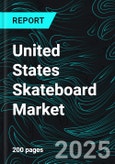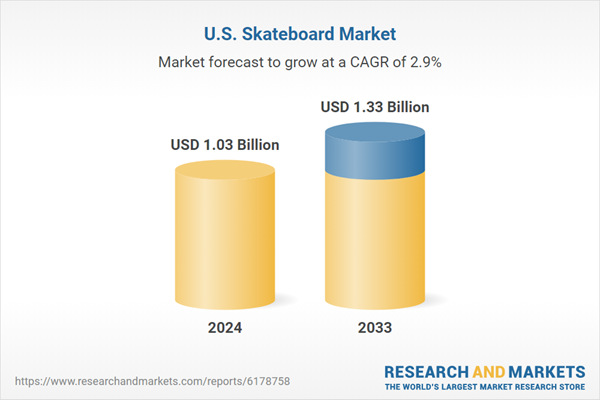United States Skateboard Industry Overview
A skateboard is a flat, narrow board with four wheels intended for riding, tricks, and recreational use. Skateboards are typically composed of durable wood or composite materials and include a deck, trucks, and wheels. They're commonly utilized for street skating, vert skating, cruising, and, increasingly, urban transportation. Skateboarding combines sport, recreation, and cultural identity, making it popular among young people globally. Variants like longboards and electric skateboards broaden their appeal beyond regular riders. Beyond sports, skateboarding has an impact on fashion, music, and urban culture, establishing it as both a recreational activity and a symbol of lifestyle expression.The skateboard market in the United States is being driven by rising teenage interest in action sports, as well as the cultural attraction of skating as a sport and a way of life. The sport's presence in the Olympics has increased visibility and participation. The expansion of skate parks in metropolitan areas improves accessibility, while social media and influencer culture raise awareness and demand for premium brands. Furthermore, the growing popularity of electric skateboards indicates customer need for convenient and environmentally responsible transportation. Supportive community activities, tournaments, and retail growth all help to enhance the market. Collectively, these forces are driving the skateboard sector in the United States to continue its expansion and modernization.
Growth Drivers for the United States Skateboard Market
Youth Participation in Action Sports
The skateboard market in the United States is primarily driven by youth participation in action sports. Skateboarding appeals to younger generations as a leisure activity, sport, and lifestyle choice that combines athleticism with self-expression. According to the Sports & Fitness Industry Association (SFIA), involvement in action sports has continuously increased among American youths, with skateboarding being one of the most accessible due to its low equipment cost and urban availability. Social media influencers, video-sharing platforms, and gaming culture all contribute to increased youth demand for skating tricks and trends. This increased interest among young customers drives sales of regular, longboard, and electric skateboards, as well as demand for branded items and skating attire.Olympic Inclusion
Skateboarding's involvement in the Olympics has substantially increased its recognition and popularity in the United States. Skateboarding, which was first presented at the Tokyo 2020 Games, featured street and park competitions, boosting the sport's respectability and global popularity. Olympic recognition in the United States drew in new viewers and spurred future skateboarders to compete. American skateboarders winning medals boosted national pride and interest. This recognition has also resulted in increasing sponsorships, investments, and support from sports groups and businesses, encouraging more participation. As skateboarding continues to appear in future Olympic Games, increased exposure is likely to draw a broader audience, driving long-term growth in both recreational and professional skateboarding in the United States.Urbanization and Skate Parks
Urbanization and the proliferation of skate parks are key drivers of the skateboard market in the United States. With more than 80% of the US population living in cities, accessible recreational infrastructure is critical. Cities and municipalities are progressively investing in skate parks to involve young people, eliminate street skating disputes, and promote healthy lifestyles. According to advocacy groups such as the Tony Hawk Foundation (now The Skatepark Project), hundreds of new skate parks have been built across the country, making skating safer and more accessible. These facilities offer separate areas for both beginners and professionals, encouraging local skating communities. The combination of urban population expansion and increased skatepark availability continues to offer favorable conditions for increased participation and demand.Challenges in the United States Skateboard Market
Safety Concerns
The skateboard market in the United States continues to face significant safety challenges. Skateboarding has a considerable risk of injury, especially among children and teenagers, who make up the majority of the user group. According to the United States Consumer Product Safety Commission (CPSC), thousands of skateboarding-related injuries are reported each year, with fractures, sprains, and head injuries being the most prevalent. While helmets, pads, and protective gear might help reduce dangers, not all riders use them consistently. Safety issues deter parents from encouraging engagement, restricting potential growth. These hazards produce unfavorable views that limit the market, particularly among younger groups, where parental permission has a big influence on recreational choices.Competition from Alternative Sports
Skateboarding confronts stiff competition from other leisure and extreme sports in the United States. Cycling, scootering, inline skating, and newer urban mobility trends like as e-scooters all attract similar audiences, particularly among young people. Furthermore, indoor sports, esports, and digital gaming are gradually diverting focus away from outside activities. Alternatives are typically more enticing to parents and younger participants due to their ease of access and perceived safety. This competitive landscape puts the skateboard market under pressure to stay relevant, forcing brands and organizations to innovate through events, endorsements, and product diversification in order to maintain demand against these new and well-established recreational activities.California Skateboard Market
California is the largest skateboard market in the U.S., driven by its strong skateboarding culture, iconic skate parks, and high youth participation. Cities like Los Angeles, San Diego, and San Francisco host numerous skateboarding events, tournaments, and professional teams, fostering both recreational and competitive skating. The state’s extensive urban population and outdoor lifestyle contribute to strong demand for traditional, longboard, and electric skateboards. Retailers and brands benefit from high visibility through social media, lifestyle marketing, and sponsorships. Despite competition from alternative sports, California remains the trendsetter for skateboarding culture, product innovation, and community engagement in the United States.Texas Skateboard Market
Texas’ skateboard market is growing steadily, fueled by urbanization, youth engagement, and investment in recreational infrastructure. Cities like Austin, Houston, and Dallas have developed skate parks and community programs that promote skateboarding among teens and young adults. The popularity of extreme sports, e-skateboards, and urban commuting options drives demand. Regional tournaments, skateboarding festivals, and social media influence also contribute to market expansion. However, challenges such as heat, limited public infrastructure in some areas, and competition from other outdoor activities can constrain growth. Overall, Texas represents a promising market for both recreational and performance skateboard segments.New York Skateboard Market
The New York skateboard market is shaped by dense urban environments, cultural influence, and a strong street skating scene. Cities like New York City, Buffalo, and Rochester feature skate parks, urban plazas, and events that support participation. The combination of tourism, youth culture, and lifestyle branding drives demand for traditional and electric skateboards. Public infrastructure and regulatory restrictions influence where and how skateboarding occurs, with skate parks serving as essential hubs. Despite space limitations and competition from other recreational activities, New York remains a key market for both casual and competitive skaters, bolstered by media exposure and community engagement.Florida Skateboard Market
Florida’s skateboard market benefits from year-round warm weather, tourism, and urban population growth. Cities like Miami, Orlando, and Tampa offer skate parks, recreational programs, and community events that foster participation. The popularity of electric skateboards for commuting and traditional skateboards for recreation supports a diverse market. Tourism-driven demand, especially in coastal and metropolitan areas, further boosts sales. However, challenges include regulatory restrictions, competition from other outdoor sports, and seasonal fluctuations in participation due to extreme weather events like hurricanes. Overall, Florida’s market is expanding steadily, supported by favorable climate, urban infrastructure, and a vibrant skateboarding culture.Recent Developments in United States Skateboard Market
- June 2023: HLC Skateboard Factory, a San Seban, Spain-based skateboard manufacturer, expanded its footprint in the U.S. market by acquiring AEND Industries, a California, U.S.-based skateboard manufacturer.
United States Skateboard Market Segments:
Product
- Street Board
- Cruiser Board
- Long Board
- Park Board
- Hybrid Board
- Others
End User
- Kids (0-9)
- Teenagers (12-17)
- Adults (18 & Above)
States - Market breakup in 29 viewpoints:
- California
- Texas
- New York
- Florida
- Illinois
- Pennsylvania
- Ohio
- Georgia
- New Jersey
- Washington
- North Carolina
- Massachusetts
- Virginia
- Michigan
- Maryland
- Colorado
- Tennessee
- Indiana
- Arizona
- Minnesota
- Wisconsin
- Missouri
- Connecticut
- South Carolina
- Oregon
- Louisiana
- Alabama
- Kentucky
- Rest of United States
All companies have been covered from 5 viewpoints:
- Company Overview
- Key Persons
- Recent Development & Strategies
- SWOT Analysis
- Sales Analysis
Key Players Analysis
- Boardriders
- Krown Skateboards
- Sk8factory
- Skate One
- Absolute Board Co.
- Alien Workshop
- Zero Skateboards
- CONTROL SKATEBOARDS INC.
- Razor USA LLC
- Almost Skateboards
Table of Contents
Companies Mentioned
- Boardriders
- Krown Skateboards
- Sk8factory
- Skate One
- Absolute Board Co.
- Alien Workshop
- Zero Skateboards
- CONTROL SKATEBOARDS INC.
- Razor USA LLC
- Almost Skateboards
Methodology
In this report, for analyzing the future trends for the studied market during the forecast period, the publisher has incorporated rigorous statistical and econometric methods, further scrutinized by secondary, primary sources and by in-house experts, supported through their extensive data intelligence repository. The market is studied holistically from both demand and supply-side perspectives. This is carried out to analyze both end-user and producer behavior patterns, in the review period, which affects price, demand and consumption trends. As the study demands to analyze the long-term nature of the market, the identification of factors influencing the market is based on the fundamentality of the study market.
Through secondary and primary researches, which largely include interviews with industry participants, reliable statistics, and regional intelligence, are identified and are transformed to quantitative data through data extraction, and further applied for inferential purposes. The publisher's in-house industry experts play an instrumental role in designing analytic tools and models, tailored to the requirements of a particular industry segment. These analytical tools and models sanitize the data & statistics and enhance the accuracy of their recommendations and advice.
Primary Research
The primary purpose of this phase is to extract qualitative information regarding the market from the key industry leaders. The primary research efforts include reaching out to participants through mail, tele-conversations, referrals, professional networks, and face-to-face interactions. The publisher also established professional corporate relations with various companies that allow us greater flexibility for reaching out to industry participants and commentators for interviews and discussions, fulfilling the following functions:
- Validates and improves the data quality and strengthens research proceeds
- Further develop the analyst team’s market understanding and expertise
- Supplies authentic information about market size, share, growth, and forecast
The researcher's primary research interview and discussion panels are typically composed of the most experienced industry members. These participants include, however, are not limited to:
- Chief executives and VPs of leading corporations specific to the industry
- Product and sales managers or country heads; channel partners and top level distributors; banking, investment, and valuation experts
- Key opinion leaders (KOLs)
Secondary Research
The publisher refers to a broad array of industry sources for their secondary research, which typically includes, however, is not limited to:
- Company SEC filings, annual reports, company websites, broker & financial reports, and investor presentations for competitive scenario and shape of the industry
- Patent and regulatory databases for understanding of technical & legal developments
- Scientific and technical writings for product information and related preemptions
- Regional government and statistical databases for macro analysis
- Authentic new articles, webcasts, and other related releases for market evaluation
- Internal and external proprietary databases, key market indicators, and relevant press releases for market estimates and forecasts

LOADING...
Table Information
| Report Attribute | Details |
|---|---|
| No. of Pages | 200 |
| Published | September 2025 |
| Forecast Period | 2024 - 2033 |
| Estimated Market Value ( USD | $ 1.03 Billion |
| Forecasted Market Value ( USD | $ 1.33 Billion |
| Compound Annual Growth Rate | 2.9% |
| Regions Covered | United States |
| No. of Companies Mentioned | 10 |









